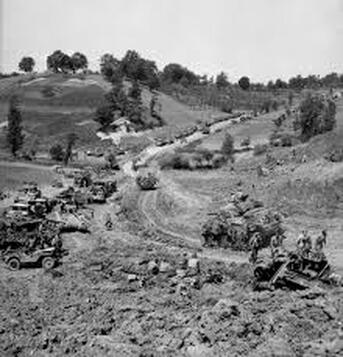However, in order to get to the Melfa, and Ceprano beyond, a hole had to be punched in the Hitler Line. This line served as the defensive fallback for the Germans retreating from the Gustav Line. The 1st Canadian Infantry Division and 5th Canadian Armoured Division, as part of the British 8th Army, drove a wedge into this line on 24 May. After extensive fighting, this wedge was widened into a breach. The Hussars were hurled into this breach.
In the breach, the men found chaos. The Germans were retreating before the advance of the Canadians. However, their retreat was sporadic. The Hussars encountered clusters of infantry and anti-tanks guns. Some of the Germans ran, others surrendered, and those that did neither were engaged and eliminated. After a series of these encounters, the Hussars had made their way to an assembly point just before the Melfa. They would spend the night there, after silencing some German artillery.
On the morning of the 25th, the regiment began their crossing to provide support to the infantry on the other side. To get there, the regiment had to take their tanks up a donkey path that had been widened by the engineers. At the top, the tanks of C Squadron encountered some stiff resistance, but after several minutes of heavy fighting, this immediate resistance was cleared. However, the regiment would experience consistent mortar strikes throughout the night of the 25th.
With the Hitler Line penetrated, the Germans began their fighting retreat. In the process they provided no fixed front, and so the battle became fluid. The enemy was engaged where he could be found: in houses, clusters of trees, and the villages. For the Hussars, the town of Ceprano was the next target. This small town on the Liri River was a key strategic target as it was at a crossroads heading out of the Valley. Taking this town would hamper the German effort to withdraw their forces from the Hitler Line.
When the infantry finally entered Ceprano, all they found was a deserted town, the Germans had already withdrawn. Unfortunately, the Hussars were stuck on the other side of the Liri River as there was no bridge to get across. So, the Hussars waited; it would be the 28th before the engineers were brought forward to put up a bridge. However, once on the other side, the advance slowed considerably. The dense foliage prevented the easy movement of tanks and material to continue the advance. Eventually, the terrain made the Sherman tanks ineffectual. Command gave the word on the 30th, the Hussars were to halt the advance their part in the Battle of the Liri Valley Their role was finished.
With the Hitler Line smashed, Allied Forces weaved their way through the Liri Valley and unto the Italian prize, Rome. The laurels would go to the Americans who, under the command of General Clark, entered a Rome empty of Germans on 4 June 1944, ending the Battle of the Liri Valley.
